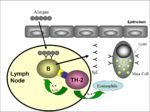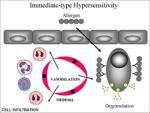Introduction
- Also known as IgE-mediated or anaphylactic hypersensitivity.
- Ranges from mild cases, such as hayfever, to life-threatening reactions, such as bee-stings.
- Antigens that induce a type I reaction are known as allergens.
- Affects face, eyes, nose and feet
- IgE has a high affinity to IgE receptors on mast cells and basophils, and so binds these receptors.
- The individual mechanisms of cell degranulation may only have a marginal effect, but the combination can be highly effective in removing parasite infection
- Eosinophils can also target IgE bound to helminths.
- May either be attracted to the site of inflammation or produced de novo in response to cytokines.
- Binding triggers their degranulation.
- Potent biological molecules are released.
- Eosinophil peroxidase.
- Eosinophil basic protein.
- Potent biological molecules are released.
- This system can be invoked with inappropriate and innocuous antigens.
- E.g. pollen.
- Under these circumstances we get hay fever.
Common allergens:
- Proteins : Foreign serum
- Plant pollens : Rye grass, ragweed, timothy grass, birch trees
- Drugs : Penicillin, sulphonamides, local anaesthetics, salicylates
- Foods : Nuts, seafood, eggs, milk
- Insect products : Bee venom, wasp venom, dust mites faeces, flea saliva
Mechanism
1. Initial antigen exposure sensitises immune system (Image 1):
- Allergen exposure causes IgE production.
- IgE coat mast cells by binding to Fc receptors.
2. Subsequent exposure to the specific allergen (Image 2):
- mast cell degranulation.
- basophils with IgE receptors are recruited and also degranulate.
Mast cells secrete mediators which cause:
- The release of inflammatary cytokines
- Steroid mediators, e.g. prostaglandins and leukotriens
- Chemoattractants (attracts mainly neutrophils but also eosinophils, monocytes and basophils and plasma)
- Some mast cell cytokines (especially eosinophils) release factors which promote growth and maturation of leukocytes
- Vasoactive and inflammatory peptides (e.g. histamine and serotonin) which causes acute contraction of smooth muscle fibres
- Leading to bronchoconstriction and vasoconstriction
- Violent constriction can lead to the expulsion of parasites
- The release of mast cell proteases
- Promotes mucous production
- Inhibits parasite interactions with the epithelial surface
- Vasodilation (leads to redness)
- Oedema (from leaky blood vessels)
3. The late phase response:
- Mediated by eosinophils.
- Takes longer (several hours) as the eosinophils are mobilised from the bone marrow.
Examples of Type I hypersensitivity
- Atopy
- Flea allergic dermatitis
- Sweet itch

